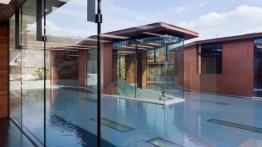Lecture: Architect Steven Holl on "Time Light"
Wednesday, November 28, 2012, 7 - 8:30pm
Steven Holl Architects is an architecture and urban design office working globally as one office from two locations: New York City and Beijing. With each project, the firm explores new ways of integrating an organizing idea with the programmatic and functional essence of a building, “always using the unique character of a program and a site as the starting point for an architectural idea.” Major works include Kiasma Contemporary Art Museum in Helsinki, Finland, the 2003 Simmons Hall at MIT in Cambridge, Massachusetts, and the 2009 Linked Hybrid mixed-use complex in Beijing, China. The Raffles City complex in Chengdu, China, includes artist and architect Lebbeus Woods' only permanent structure, The Light Pavilion.
Holl’s architecture and writing has undergone a shift in emphasis, from his earlier concern with typology to his current interest in phenomenology. Along with Juhani Pallasmaa and Alberto Perez-Gomez, Holl wrote essays for the Japanese architectural journal A+U under the title “Questions of Perception: Phenomenology of Architecture.” The publication was reissued as a book in 2006.
Introduced and moderated by Sanford Kwinter, writer, theorist, and professor of architectural theory and criticism at the Harvard Graduate School of Design and codirector of the Master’s in Design Studies Program.
This lecture is co-sponsored by the Architectural League of New York.
FREE for current students/faculty/staff of The Cooper Union and League members; $15 for non-members. For more information on ticketing please go here.
Located in The Great Hall, in the Foundation Building, 7 East 7th Street, between Third and Fourth Avenues







